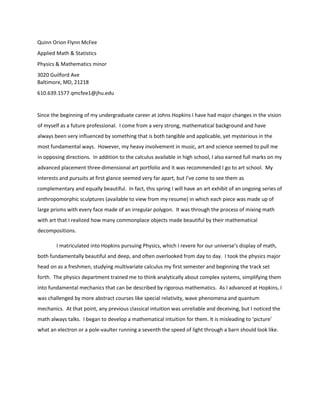
CVUpdated
- 1. Quinn Orion Flynn McFee Applied Math & Statistics Physics & Mathematics minor 3020 Guilford Ave Baltimore, MD, 21218 610.639.1577 qmcfee1@jhu.edu Since the beginning of my undergraduate career at Johns Hopkins I have had major changes in the vision of myself as a future professional. I come from a very strong, mathematical background and have always been very influenced by something that is both tangible and applicable, yet mysterious in the most fundamental ways. However, my heavy involvement in music, art and science seemed to pull me in opposing directions. In addition to the calculus available in high school, I also earned full marks on my advanced placement three-dimensional art portfolio and it was recommended I go to art school. My interests and pursuits at first glance seemed very far apart, but I’ve come to see them as complementary and equally beautiful. In fact, this spring I will have an art exhibit of an ongoing series of anthropomorphic sculptures (available to view from my resume) in which each piece was made up of large prisms with every face made of an irregular polygon. It was through the process of mixing math with art that I realized how many commonplace objects made beautiful by their mathematical decompositions. I matriculated into Hopkins pursuing Physics, which I revere for our universe’s display of math, both fundamentally beautiful and deep, and often overlooked from day to day. I took the physics major head on as a freshmen, studying multivariate calculus my first semester and beginning the track set forth. The physics department trained me to think analytically about complex systems, simplifying them into fundamental mechanics that can be described by rigorous mathematics. As I advanced at Hopkins, I was challenged by more abstract courses like special relativity, wave phenomena and quantum mechanics. At that point, any previous classical intuition was unreliable and deceiving, but I noticed the math always talks. I began to develop a mathematical intuition for them. It is misleading to ‘picture’ what an electron or a pole-vaulter running a seventh the speed of light through a barn should look like.
- 2. Instead, I looked for symmetry, phase shifts, and probability distributions to see how systems ought to behave. My junior year I started doing undergraduate research for the High Energy Physics Department, writing signal selection programs and fitting data to identify special muon decays of the Higgs and Z’ boson jets using a C++ based language called ROOT. In a few days, I had to build this language from the source code and pick up the language on the go independently. I have grown used to rely on myself and adapt to new situations quickly. I became less interested in the physics of particle collisions and more interested in properties of their distributions. The same distribution for the energy-momentum of particle collisions could be used to describe the distribution of the number of patients in a hospital over a year. It was exciting to use data straight from CERN and Fermilab, but, as the research continued, I grew more interested in the structure and management of these enormous databases. It was then that I added Applied Math and Statistics to my major and became a Physics minor. Discrete mathematics opened my mind to applications of math beyond the natural world. The more I learned as an Applied Math student, the more I saw the beauty in abstract or artificially constructed relationships and the mathematics that describe, analyze, and optimize these relationships to solve a motley of real world problems or even a game of marble solitaire. Before studying applied math, I would have never known how interesting an airline schedule could be. I am presently working on a completely data driven research project, developing the database for a global, interactive statistical map in R, which has only made me more interested in managing large amounts of data, making sense of it, and reorganizing it in a meaningful way. I am now equipped with many tools for running hypothesis testing, different linear and robust regression for parameter estimation and running residual diagnostics for determining (non)normality or (non)constant variance. In addition to R, I am continuing to learn more data driven packages in development languages like python (numpy, scipy, etc.) Above all I have gained the perseverance to take onto any project and see it through to the very end. Currently I am interested in using computational statistics to help design pharmaceutical testing and analyze the effectiveness of these tests, imaging, and data mining. I wish to not only contribute to the pool of knowledge in the future, but use my love of math to further contribute to the wellness and safety of others and our environment. I would love to contribute in any way I can and I look forward to hearing from you.